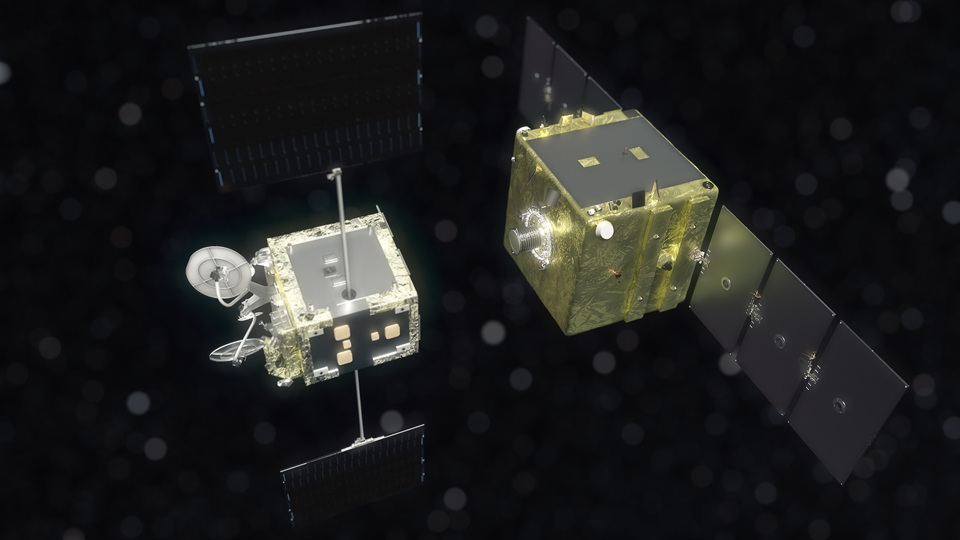Astroscale's ELSA-M (End-of-Life Service by Astroscale-Multiple) in-orbit demonstration mission offers an innovative, proactive solution to a growing problem: space debris. With Terma’s state-of-the-art Electrical Ground Support Equipment (EGSE), the ELSA-M mission is well supported.
‘Sustainability’ has truly entered the space engineer dictionary. With the industry's increasing focus on space sustainability, Astroscale aims to set a precedent with its ELSA-M servicer by conducting the first commercial end-of-life removal service. By deorbiting a full-sized customer satellite in 2026, this mission will demonstrate both the feasibility of debris removal as well as pave the way for more responsible end-of-life asset management in orbit.
Terma was able to contribute to this groundbreaking initiative by delivering a turnkey Central Checkout System (CCS), a critical element of the Electrical Ground Support Equipment (EGSE) for ELSA-M. This system plays a key role in ensuring the mission’s readiness and success.
Advanced EGSE Capabilities for ELSA-M
A Landmark Mission in Space Sustainability
The ELSA-M mission represents a pivotal moment in the global effort to address space debris. As regulatory bodies and industry stakeholders push for greater responsibility in space operations, Astroscale is setting new benchmarks with its end-of-life mission. The 2026 in-orbit demonstration is poised to deorbit a full-sized satellite, marking the first commercial end-of-life service and establishing a critical service for satellite operators to retire their assets safely and sustainably.
Terma supports Astroscale UK with a comprehensive, CCS5-based solution that enhances their Assembly, Integration, and Testing (AIT) capabilities. Our advanced EGSE infrastructure ensures that the ELSA-M servicer is prepared to meet its ambitious goals
Mission Highlights
- Mission Objective: First commercial end-of-life service, targeting the deorbiting of a full-sized satellite.
- Planned Launch: 2026
- Target Orbit: 745 miles (1,200 kilometers)
Terma’s Contribution: A Turnkey EGSE Solution
Central Checkout System (CCS5)
Terma provided a fully integrated, CCS5-based solution for the ELSA-M mission, delivering a sophisticated EGSE capability without the need for custom software development. Built to meet space standards (CCSDS, ECSS), the CCS5 system is highly configurable, ensuring seamless adaptation to mission-specific requirements. This user-friendly, automated system helps streamline AIT processes, allowing for cost-effective, efficient testing and integration.
Test Sequence Controller (TSC) Software
To expedite early preparation, Terma supplied Astroscale UK with its TSC software, a simplified version of our EGSE solution that enables quick setup and testing. This allowed Astroscale UK to efficiently build their EGSE capabilities ahead of the full system’s deployment, ensuring no delays in their mission timeline.
uNIS for Seamless Connectivity
Astroscale UK also adopted Terma’s uNIS software, which implements the CCSDS SLE protocol for communication between ground stations and control centers. This solution supports the "test as you fly" methodology, ensuring operational consistency across various phases of the mission. This level of integration is critical to advancing the mission’s overall readiness and success.
"Terma’s CCS5 system has been a fundamental part of achieving mission readiness for the ELSA-M project, helping to keep us on track with key project milestones."
Mahesh Kumar Yedla
AIT Electrical Team Lead, Astroscale UK
Outcome: Enhancing Efficiency and Readiness
Astroscale is not only on schedule for the 2026 demonstration but is also laying the groundwork for scaling up its ELSA-M program. Terma’s efficient delivery and customizable solutions have played a key role in mission preparedness for this crucial first step.
As Astroscale looks to the future, the success of ELSA-M will mark a major milestone in space sustainability, showcasing the potential for ongoing advancements in debris removal and satellite end-of-life management for a cleaner, safer, and more sustainable space environment.




